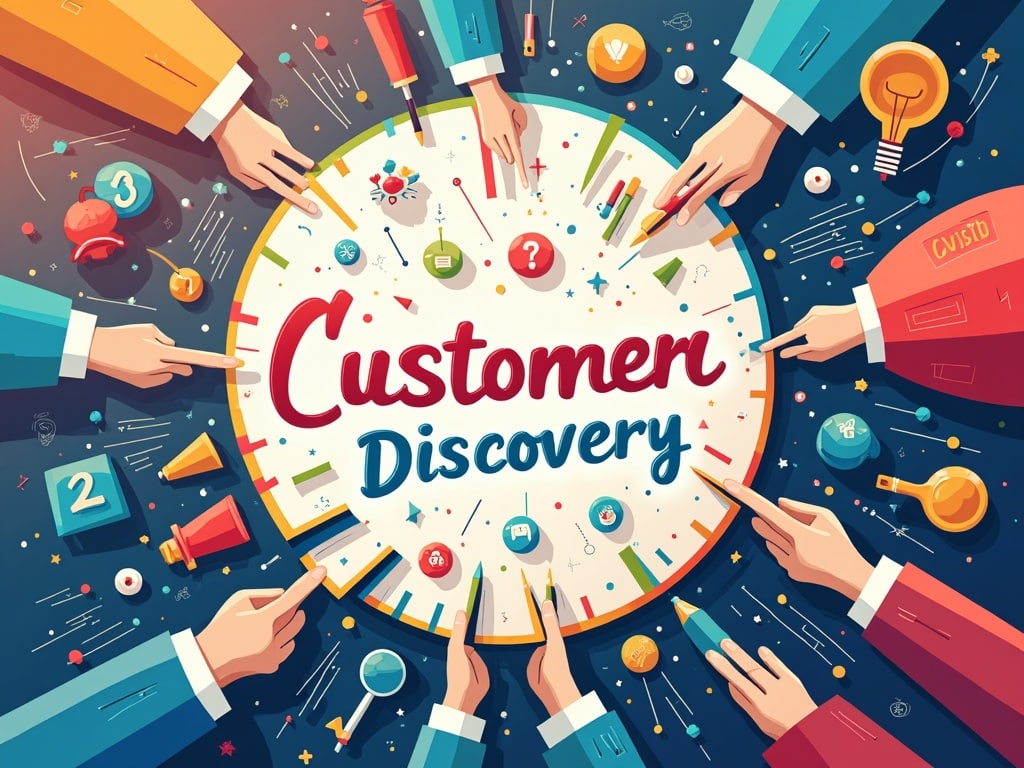How to Do Customer Discovery: A Comprehensive Guide
Imagine pouring your heart and soul into building a product, only to launch it to crickets. No sales, no buzz, just the deafening silence of unmet expectations. This is the nightmare scenario that customer discovery aims to prevent. It's the crucial process of understanding your potential customers, their problems, and whether your solution truly resonates with them. Think of it as laying the foundation for a successful product launch, one conversation at a time.
What is Customer Discovery?
Customer discovery is more than just market research; it's a deep dive into the lives and needs of the people you hope to serve. It's about validating your assumptions, identifying pain points, and refining your product idea based on real-world feedback. It's a continuous process, not a one-off event, that helps you ensure you're building something people actually want.
Think of it as a detective's work. You have a hypothesis – People need a better way to organize their recipes – and now you need to gather evidence to prove or disprove it. You'll be asking questions, listening intently, and piecing together the puzzle of your customer's needs. This proactive approach minimizes risk and maximizes your chances of creating a product that thrives.
Why is Customer Discovery Important?
**Reduces Risk:Launching a product without understanding your customer is like navigating a ship in a storm without a compass. Customer discovery provides you with the insights you need to steer clear of disaster.
**Saves Time and Money:By validating your assumptions early on, you can avoid wasting valuable resources on building features or products that no one wants.
**Improves Product-Market Fit:Customer discovery helps you fine-tune your product to perfectly match the needs of your target audience, increasing your chances of achieving product-market fit.
**Builds Customer Relationships:Engaging with potential customers during the discovery process allows you to build relationships and create a community around your product.
**Uncovers Unexpected Opportunities:You might stumble upon unforeseen needs or opportunities that you hadn't considered, leading to innovative product features or even entirely new product ideas.
The Four Phases of Customer Discovery
Customer discovery, popularized by Steve Blank in his book The Four Steps to the Epiphany, is structured around a series of phases, each building upon the previous one:
1. **Hypothesize:Develop your initial business model canvas and assumptions.
2. **Test:Get out of the building and interview potential customers, testing each element of your business model.
3. **Pivot or Proceed:Analyze your findings and decide whether to pivot your approach or proceed with your original plan.
4. **Verify:Refine your product and business model based on customer feedback and prepare for scaling.
Let's break down each phase with actionable steps.
Phase 1: Hypothesize
Before you start talking to customers, you need to define your assumptions. This involves creating a business model canvas, which outlines the key aspects of your business, including:
**Customer Segments:Who are you trying to reach? Be as specific as possible.
**Value Proposition:What problem are you solving for your customers? What benefits do you offer?
**Channels:How will you reach your customers?
**Customer Relationships:What kind of relationship will you have with your customers?
**Revenue Streams:How will you make money?
**Key Activities:What activities do you need to perform to deliver your value proposition?
**Key Resources:What resources do you need to perform your key activities?
**Key Partnerships:Who are your key partners?
**Cost Structure:What are your main costs?
For each element of the business model canvas, write down your assumptions. These are your hypotheses that you will test in the next phase. For example, if you're building a recipe organization app, your hypotheses might include:
Busy parents struggle to find time to plan and cook meals.
Users are willing to pay $5 per month for a recipe organization app.
Social media is the most effective channel for reaching our target audience.
Phase 2: Test
This is where the real work begins. It's time to get out of your comfort zone and talk to potential customers. The goal is to validate or invalidate your hypotheses by gathering real-world feedback.
**Identify Your Target Audience:Based on your customer segments, create a list of people who fit your ideal customer profile.
**Craft Your Interview Questions:Prepare open-ended questions that encourage your interviewees to share their experiences, pain points, and needs. Avoid leading questions that might bias their responses. Some example questions:
Tell me about the last time you tried to solve [problem].
What are the biggest challenges you face when [related activity]?
What solutions have you tried in the past, and what were the results?
What would your ideal solution look like?
**Conduct Interviews:Aim for at least 10-15 interviews per customer segment. You can conduct interviews in person, over the phone, or via video conferencing.
**Listen Actively:Pay close attention to what your interviewees are saying, both verbally and nonverbally. Take detailed notes and record the interviews (with their permission).
**Focus on Problems, Not Solutions:Resist the urge to pitch your product. Instead, focus on understanding their problems and needs.
**Be Open to Surprises:Be prepared to hear things you don't expect. The goal is to learn, even if it means challenging your assumptions.

Phase 3: Pivot or Proceed
After conducting your interviews, it's time to analyze your findings and decide whether to pivot your approach or proceed with your original plan.
**Analyze Your Data:Review your interview notes and recordings, looking for patterns, trends, and key insights.
**Validate or Invalidate Your Hypotheses:Determine which of your assumptions were validated by your customer interviews and which were invalidated.
**Identify Pivots:If your hypotheses were largely invalidated, you may need to pivot your business model. A pivot involves making a significant change to one or more elements of your business model canvas. Types of pivots can include customer segment pivots (targeting a different group of customers), value proposition pivots (offering a different set of benefits), or channel pivots (reaching customers through different channels).
**Refine Your Business Model Canvas:Update your business model canvas based on your findings, incorporating the insights you gained from your customer interviews.
Phase 4: Verify
The final phase involves verifying your refined product and business model and preparing for scaling.
**Build a Minimum Viable Product (MVP):Create a basic version of your product with just enough features to satisfy early customers and gather feedback.
**Test Your MVP:Launch your MVP to a small group of users and gather feedback on its usability, functionality, and overall value.
**Iterate Based on Feedback:Use the feedback you receive to iterate on your MVP, adding new features, improving existing ones, and fixing any bugs.
**Prepare for Scaling:Once you've achieved product-market fit and have a validated business model, you can begin to scale your business.
Tools and Techniques for Customer Discovery
Several tools and techniques can help you streamline your customer discovery process:
**Surveys:Use online survey tools like SurveyMonkey or Google Forms to gather quantitative data from a larger audience.
**Customer Relationship Management (CRM) Systems:Use a CRM system like Salesforce or HubSpot to track your interactions with potential customers and manage your customer data.
**Analytics Tools:Use analytics tools like Google Analytics or Mixpanel to track user behavior on your website or app.
**Social Media Listening:Monitor social media channels for mentions of your product, brand, or industry to gain insights into customer sentiment and identify potential opportunities.
**A/B Testing:Use A/B testing to compare different versions of your product or marketing materials and determine which performs best.
**The Mom Test:This refers to a simple rule for interviewing: talk about the customer's life instead of your idea, and avoid leading questions. If your mom would say yes to your questions, they are bad questions!
Common Mistakes to Avoid
**Talking Too Much, Listening Too Little:Customer discovery is all about listening to your customers. Resist the urge to pitch your product and focus on understanding their needs.
**Asking Leading Questions:Avoid asking questions that might bias your interviewees' responses. Ask open-ended questions that encourage them to share their experiences and opinions.
**Interviewing the Wrong People:Make sure you're interviewing people who fit your ideal customer profile.
**Not Taking Detailed Notes:Take detailed notes during your interviews so you can accurately analyze your findings later.
**Ignoring Negative Feedback:Don't dismiss negative feedback. It can be just as valuable as positive feedback, as it can help you identify areas for improvement.
**Being Afraid to Pivot:Be prepared to pivot your business model if your assumptions are invalidated. The goal is to find a product that solves a real problem for a specific audience.
Turning Insights into Action
Customer discovery isn't just about gathering data; it's about translating those insights into actionable steps that improve your product and business.
**Prioritize Feedback:Not all feedback is created equal. Prioritize the feedback that comes from your target audience and that aligns with your overall business goals.
**Create User Personas:Develop detailed user personas based on your customer research. These personas will help you visualize your target audience and make more informed decisions about product development and marketing.
**Develop a Product Roadmap:Create a product roadmap that outlines the features and improvements you plan to make to your product based on customer feedback.
**Communicate with Your Customers:Keep your customers informed about the changes you're making to your product based on their feedback. This will show them that you value their input and are committed to building a product that meets their needs.
Customer discovery is an ongoing process. As your business evolves, so too should your understanding of your customers. By continuously engaging with your target audience, you can ensure that you're always building a product that meets their needs and that you're staying ahead of the competition.
Conclusion
Mastering the art of customer discovery is not just a step, but a continuous journey towards building something truly valuable. By diligently following these steps, avoiding common pitfalls, and embracing the feedback loop, any entrepreneur can significantly increase their chances of creating a product that not only resonates with customers but also thrives in the market. So, get out there, start talking, and listen intently – your next big breakthrough might just be a conversation away.

